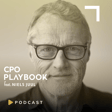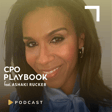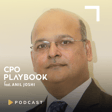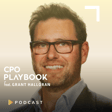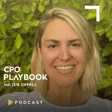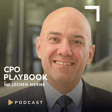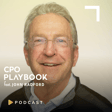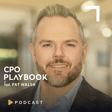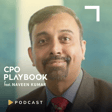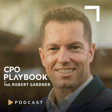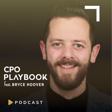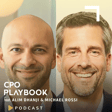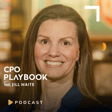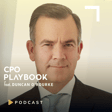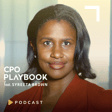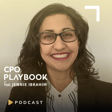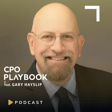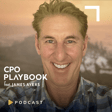Introduction to the CPO Playbook Podcast
00:00:05
Speaker
Hello, everyone. I'm Felicia Shakiba, and you're listening to the CPO Playbook Podcast. Join me and my guests as we feature insightful conversations with HR leaders, people scientists, and executives from diverse industries and functions, offering valuable perspectives on the future of work.
00:00:24
Speaker
Discover a unique outlook on navigating the complexities of the modern-day working world, exploring innovative strategies in talent management and corporate culture from the chief people officer's perspective. Tune in to stay ahead of the game when it comes to all things people related.
Recap of Previous Episode Highlights
00:00:45
Speaker
Welcome back to the second part of this year's holiday special. In our previous episode, we had perceptive clips from former Chief People Officer Colleen McCreary from Credit Karma, Anne Lacam from Harvard Business School and Walt Disney Animation, and the Co-Chief Creative Officers Hugo Vega and Diego Macano.
00:01:06
Speaker
of AKQA Sao Paulo.
Insights into HR and Technology
00:01:08
Speaker
In this episode, we'll feature conversations from Stanford lecturer and podcast host of Think Fast, Talk Smart, Matt Abrahams, John Strauss from Greenhouse discussing AI and HR technology,
00:01:23
Speaker
Chief People Officer at Buzzfeed Chandler Bonden, and many other remarkable guests. Sit back, relax, and savor the thought-provoking insights unearthed during these extraordinary interviews in 2023.
Are Flatter Hierarchies Always Better?
00:01:46
Speaker
During a pivotal moment, Dr. Daisy Graywall, the senior manager of People Analytics and Research Partners at Intuit, challenged a misconception regarding organizational structures. It's common for many companies to pursue a flattened design in the hopes of boosting agility and reducing decision making complexities.
00:02:08
Speaker
However, Dr. Greywall defied this notion by presenting compelling evidence that contradicts the belief that flatter is always better. Here's the clip.
00:02:22
Speaker
So one of my first projects was to answer questions about what's optimal when it comes to both managers' fans, so the number of direct reports in Manager House, and then the number of organizational layers you have in the company if you start with the CEO in the state.
00:02:40
Speaker
So like most people, before I started this project, I had heard over and over from the media and business literature that flatter is utter and companies should be as flat as possible if they want to be innovative and quick and agile, as well as transparent. So I was actually very surprised by my own findings, which included both external research and internal research to learn that flatter isn't necessarily utter. So I looked at the data.
00:03:09
Speaker
Consistently, I found that either it didn't really matter, it was a pretty small impact, or in many cases, people actually prefer more hierarchy and they feel comfortable when there is a good amount of hierarchy.
00:03:25
Speaker
That's so interesting. In your research on team size and hierarchy levels, you mentioned that the number of middle managers doesn't necessarily determine decision making speed. So can you elaborate on the factors that have a more significant influence on effective decision making within an organization?
00:03:44
Speaker
Yeah, what we've found and what we hear from employees mostly is that the speed of decision making is more about the decision making process than where you sit in the organization or how big the team is that you work on. So the things that do seem to matter related to that decision making process are, how many approvals do I have to get? How many sign offs do I need to move forward? And where are those people in the organization?
00:04:14
Speaker
what is the appetite for senior leaders in empowering the teams below them to go ahead and make decisions on their own without that senior leader input, especially for decisions that could be reversible. And then through my research, I also found that there were things that on the surface don't seem really related, but actually make up big deaf friends for how quickly employees can move in their day-to-day jobs. So one
00:04:39
Speaker
that really surprised me was the number of project managers you need to work with to get something done. And the other thing that helped me understand why I didn't find kind of the common perspective that flatters better is because when you really think about most white collar workforces, there are very few of us who are spending most of our time with our direct managers. Most people are not doing the same job as their manager.
00:05:07
Speaker
They're not even doing the same job as their peers. They're spending a lot of time in cross-functional teams. And so their main dependency is when it comes to moving answer tends to be people who report to other managers. And so those connections don't show up on the organizational charts. So it's really hard to study them in sort of a traditional approach to spans and layers. And yet those are the connections where crucial decision processes tend to break down and make things harder for employees.
AI's Role in HR Technology
00:05:40
Speaker
Executive focus isn't solely centered on organizational design, but also encompasses the realm of AI, of course. During my attendance at the HR Technology Conference in Las Vegas this year, I engaged in conversations with several founders and executives
00:05:57
Speaker
of HR tech companies. They provided valuable insights into their current offerings for organizations, particularly emphasizing AI's potential value within their technology. Among the compelling stories shared, co-founder John Strauss from Greenhouse stood out. He not only shared the updates on their offerings, but also provided intriguing perspectives on the future trajectory of AI and HR technology.
00:06:28
Speaker
For me, like my previous job, you wouldn't have guessed I would start a recruiting software company. I was head of international, the initial business, a company called Baby Center. It was a website for new and expecting parents. And we were launching it in 20 countries around the world. So I was traveling the world building a baby website. And what we figured out was that
00:06:45
Speaker
The key thing for success wasn't about the content of the technology, it was just about the editor. If we could find the right local editor who could adapt the content, it would work. And so we had to build this system to say, how do we hire a pregnancy editor in China, in India, in Brazil, in Russia, in all these different countries? I don't know pregnancy editors in any of these countries. And so we had to build a whole system for how would we find people, how do we interview them, how do we test their skills, their local language, and then eventually hire an onboard them.
00:07:14
Speaker
And it worked. We hired dozens and dozens of people. We built these wonderful websites. To this day, years and years later, it's still a very successful website helping tons of people. And so the learning from that was that if you can quickly, predictably bring on the very best talent, you can solve most business problems.
00:07:30
Speaker
That's a huge weapon. And so when I was working with my old friend, Dan, as a developer, had actually developed a lot of the same theories from his company he had been doing. And we realized that when we talked to friends who were running companies, they would all say, hiring is one of our biggest challenges. And we'd say, so what are you doing about that? And then they would say, gibberish. And we're like, no, this is really important. You need to do the things that I did at Baby Center or Dan did at Lab 49.
00:07:53
Speaker
we realized, oh, there's this huge amount of value to be created in helping companies become great at hiring. And so the founding question of the company was, if a company decided to commit itself to be great at hiring, what software would it need? What technology would help them? And so we didn't start from the perspective of, I hate my ATS, I want to build a better ATS. We started from the perspective of, as a CEO, well, what I want to help me become great. And so that was the genesis of the company. It's an incredible story. What's on the horizon for Greenhouse?
00:08:22
Speaker
So the future, well, you know, it starts with our missions. Our mission is to help everyone become great at hiring. And so there's a couple pieces of that. One is everywhere. So that means there's lots of different types of companies that we don't serve today. So that's a part of this geographically. We're now spreading out all over the world and we're building offices in Europe, but there's different types of companies. So historically we sold to a lot of fast-growing tech companies in Silicon Valley.
00:08:42
Speaker
Now we've expanded to many different types of companies beyond that, many different types of hiring beyond. And then the other big piece of it, we say become great at hiring, is that not all hiring problems are ATS problems. It's bigger than that. And so what we're finding is that there's a lot of really critical hiring problems that are bigger than what you would do in your typical ATS. And so a lot of more sourcing problems. How do I figure out what job ads to buy? How do I figure out what agencies to use? How do I figure out which sources to use?
00:09:07
Speaker
There's D&I problems of like, how do I become more fair? How do I mitigate bias? There's downstream problems. How do I learn? Did the hires I make actually work out? And are we having a great quality of hire? And so all of those are just more problems within hiring that we think fits under the tent of our mission. And so that's kind of what guides us that we'll keep doing.
00:09:27
Speaker
And does AI play a role in the platform today or in the future? Of course, yeah. And so I think machine learning and AI is something we've been working with for a while. And I think now what we're seeing is that things that seemed impossible like four years ago that were like, oh, that would be really hard to build have suddenly become like really doable. And so.
00:09:45
Speaker
For us, it's less about saying, how can we use AI? It's more saying, well, what problems can we solve that AI, that we couldn't before, right? And so I think that there's a bunch of obvious use cases, right? The things like put an LLM inside of every text box. And so you can imagine writing job descriptions or writing interview questions. It's very helpful with that. That's great. Like obviously we're, everybody's working on stuff like that.
00:10:07
Speaker
There's also other use cases that are a little bit less obvious, things like it does really good categorization. So we're able to feed in all these different jobs from our customers and say, like, hey, actually, it turns out this job you're opening, based on the job description and the title, we think it's just like these other 1,000 jobs at these other companies. We have the underlying model where we can say which jobs are similar to each other, which allows us to create really interesting benchmarks. The world looks like chat GPT, but it'll actually give you some really profound insights from this corpus of data that we have. So automation things we can do, right?
00:10:37
Speaker
get to the end of the process and say, oh, given this job description and this person's resume and all the interview feedback we collected against them, here's a two paragraph summary of why we're gonna make this higher. And then you can send that around in your offer approval email. There's lots you can do. I think that I'd also say there's another category of AI stuff around, can you use AI to decide who to hire and make decisions between person A and person B? That I think a lot of people have a lot of nervousness about, as do we. And so I think it's an area where we research, but I don't know that we're ready to put a stake in the ground and say, we're doing that quite yet.
00:11:08
Speaker
Seems ideal, doesn't it? Streamlining all that administrative work sounds fantastic. However, the real challenge lies in convincing leadership to embrace the new technology within the organization. It's far from effortless when you're navigating budget constraints and encountering individuals resistant to change
00:11:29
Speaker
or unwilling to step outside their comfort zones to learn something new.
Transitioning to In-House HR Technology
00:11:34
Speaker
Brad Williams, the head of HR Technology and People Analytics at Northwestern Mutual, tells us how he does it.
00:11:42
Speaker
Who were you collaborating with most? How hard or difficult was it to get leadership's attention? What did that look like for you? There's a couple of things that I did, a lot of lessons learned along the way. But a lot of this was, I used kind of, and this is true of a lot of arguments that I make.
00:12:03
Speaker
both logic and emotional argument to the stakeholders that I'm trying to influence. And from my perspective, it starts with the top, my boss, our head of HR, CHRO, and getting his support, getting his buy-in. But honestly, it doesn't end there. I needed to convince my peers to convince even their teams that this was the right thing to do, and both
00:12:29
Speaker
bringing technology and data together, but also shifting to an in-house model from an HR technology perspective. And the analogy I kind of used was, especially on bringing an in-house model to the HR technology team, was imagine we're building a house. And all of our stakeholders, the customer, the person who was getting the house built, we weren't happy. But we felt like we just needed to get the project done. We needed to get the house built.
00:12:57
Speaker
I had to go and convince those individuals that, hey, let's take a pause. Let's go out and find the right builders. Let me go do that. And I'll find the right builders. I'll find the right general contractor so that we can build the right house and it's going to prevent all these future problems.
00:13:17
Speaker
And so that was kind of the analogy that I use as I went around and convinced because nobody, most of my peers weren't happy with the service levels they were receiving from the third party. And part of that was third parties aren't nearly as invested and also don't have to live with the consequences of many of their
00:13:35
Speaker
implementations or many of their changes that they're making. If we bring those resources in-house, and part of my pitch was for the same amount of money, we're going to get better outcomes. The team's going to be held more accountable because you can follow up directly with them and say, hey,
00:13:51
Speaker
this isn't working like you promised it would and we can fix that, we can build that. And so it was a very logic-based argument to get them on board, but by no means was it easy. But once they saw the vision and having that trust and credibility built up over the first year of my tenure here, I think sold them on making that a reality.
00:14:14
Speaker
I love that you approached your strategy with basically how everybody makes a decision, which is either in the logic camp or the emotional camp.
00:14:24
Speaker
So covering both camps kind of assures that you're going to have some sort of influence, right? But that's exciting. I love that approach. How do you do approach leadership to secure their commitment to this strategic shift of transitioning from an outsourced HR tech model to an in-house one?
00:14:45
Speaker
I really started with my peer network, the folks that were going to be impacted by the work that was getting done because I knew there was going to be a disruption along the way that we were going to have to slowly wean off our third party support while we built and sourced our
00:15:06
Speaker
newly internal team to go out and do that work. And even after we got those resources, there was an onboarding period where they needed to become familiar with NM, with the environment, with the infrastructure that we have, with our strategy, our direction. And so it wasn't you start them on day one and it's smooth sailing thereafter. It was a bumpy road and I went out and made sure
00:15:32
Speaker
that they were prepared for some of the challenges. But again, keeping the vision in mind and got their buy and got their support and then took that to our head of HR and said, look, I've got my peers supportive of this for the same dollar investment, which I think was the big thing that he was worried about. So for the same dollar investment, we can get better outcomes
00:15:57
Speaker
we can get things done quicker we can get things done more efficiently and i've got. All of my peers supported he gave me the green light to go out and do that again with the understanding that the dollars needed to work itself out so we had to go out and hire thoughtfully.
00:16:16
Speaker
and move that along while also being aware of the spend that we had from a third party standpoint. And there were checks along the way to make sure that we weren't veering off course and that we were still achieving the outcomes that I promised my peer group and my peers.
Strategies for Effective Meetings
00:16:38
Speaker
Communicating with your peers and managing up is not easy, as Brad explains.
00:16:44
Speaker
But knowing how to communicate across the organization or with your teams could lead to your ability to win people over. Matt Abrahams, a Stanford lecturer and the podcast host of Think Fast, Talk Smart.
00:17:00
Speaker
who was renowned for his exceptional communication skills, had a lot to say. During my interview with him in episode 16, our conversation gravitated towards the colossal theme of meetings. Meetings hold significant cultural weight as they establish the communication norms within teams, with managers, and across different functions. Their potency lies in their ability to either propel productivity
00:17:28
Speaker
Or, if inadequately structured, derail progress and consume valuable time. Matt shared a pivotal insight on transforming meetings into more productive sessions with just a few easy tips. Here's the golden-negative truth and productivity on how to make meetings meaningful.
00:17:50
Speaker
Effective meetings are where a lot of the decisions happen, especially in cross-functional projects. What strategies can leaders employ to ensure meetings result in clear takeaways and actionable outcomes? And how might an organization scale these strategies?
00:18:08
Speaker
I love this question. I think meetings are amazingly important, yet are so poorly executed. People who spend their whole academic career studying this, I think we should all listen to what they say and do. I'm going to start at the beginning. First, the purpose of the meeting needs to be very clear.
00:18:25
Speaker
And often meetings are band-aids for bigger problems that exist. So there's a problem in how we implement or how we bring a product to market. What do we do? We just keep throwing meetings at them to try to fix the problem. Get to the systemic issue at hand, make the changes. Meetings are not band-aids. Second, when you call a meeting, make sure you figure out who the right people are, who should attend. Often we will invite more people than are needed.
00:18:53
Speaker
Third, how you name your meeting, how you invite people to your meeting really matters as well. I think the most underutilized expectation setting tool for effective meetings is the meeting invite. We slap a name on it, a URL or a room location and that's it.
00:19:09
Speaker
You can do a lot of work in a meeting invite. You can set the agenda. If you're using specific tools, especially a virtual, you're using the whiteboard or reactions buttons, tell people, put links to tutorials so people know how to use the tools. I always put a provocative question or a challenge in my calendar invite. So when people come to the meeting, we start with that.
00:19:30
Speaker
People don't like going to meetings the way we start most meetings is reviewing the previous meeting how ludicrous is that you don't want to be here so i'm gonna remind you of the previous meeting where you didn't want to be there either that's silly. Rather start with something engaging keep on track keep on time have a facilitator who might not be the leader.
00:19:48
Speaker
in the room making sure that voices are heard if your hybrid people who are remote their voices are being brought into the room that can lead to better time management better focus on goals when your meetings are done at the end of the meeting take a few moments to review the quality of the meeting not rehash what was said.
00:20:05
Speaker
but what could we do to do something different or better you know that definition of insanity doing the same thing over and over again expecting different results we should not run our meetings like that we should make adjustments to make them better and then finally in one place post all of the actions that came out of it if you're taking notes or minutes post them all in one place train people to check those out to make sure everything was captured appropriately.
00:20:29
Speaker
I'm sorry, I get very passionate about meetings. I think we waste meetings. I think meetings could be so much more effective. And you gave me permission to get up on my soapbox. So thank you.
00:20:42
Speaker
It was truly an extraordinary privilege to have Matt on the show, undoubtedly eliciting excitement among his fanbase for his episode. However, I was keen on featuring a guest from a different geographical setting to provide a broader global viewpoint.
Building Diverse Executive Leadership Teams
00:21:01
Speaker
an accomplished CFO, board director, and entrepreneur with a 28-year journey across clean technologies, joined us from London, bringing with him a wealth of experience in acquiring businesses as an investor and entrepreneur. With a background in finance, Mateo shed light on a crucial aspect. What truly adds value to a company?
00:21:28
Speaker
Surprisingly, his focus wasn't on the product or market share, but rather honed in on the significance of effective leadership. What advice would you give to entrepreneurs looking to build their executive leadership team from scratch to ensure that they have the right blend of skills and attitudes? Yeah, I mean, for entrepreneurs, they tend to be very lonely figures in our society because
00:21:57
Speaker
Society doesn't understand the incredible contribution they're giving to us by creating jobs, by creating wealth, but the entrepreneurs themselves need more education on how they can improve their own wealth. So for entrepreneurs embarking on the younger of constructing an executive leadership team from the ground up, the imperatives are really manifold. The foremost consideration is really what I would call it
00:22:27
Speaker
an orchestration of a blend of skills, competency and attitudes. This, again, I would call it amalgamation, is the bedrock upon which a leadership team's effectiveness eventually rested. Apparative to place an emphasis on the cultivation of a diverse and complementary array of skills. So additionally, the implementation of attitudes encompassing, I would say, adaptability, definitely passion,
00:22:54
Speaker
resilience all these are instrumental really and these attitudes should be really carefully aligned with the the overarching vision and values of the company really so and ultimately that will position the team as a potent compound for organizational growth
00:23:15
Speaker
And again, I will say this is where there is a world of extra education that entrepreneurs deserve to receive when they take the risk of creating a new business, they create the risk, risking their money, really. And then and by doing that, they create jobs, they create, they create what we see in the economy.
00:23:35
Speaker
I have one follow-up question for you. You talked about the different types of skill sets that are critical, like the different types of roles that are critical for leadership executive team to thrive. How important is it to have someone on the executive team in a people-focused role like a chief people officer? When does that become critical to have that executive at that level?
00:24:01
Speaker
It's always critical, I would say. Really, when you go for organizational growth, often you find complexities.
00:24:10
Speaker
related to scaling operation and strategic imperative of benchmarking in the markets, really. So what I was saying before, the adaptation and the diversity of the team requires really a very careful management from the Yuma resource standpoint.
00:24:32
Speaker
team has to have a diversity in the skill of the player. It's a bit like any sport you play. In sports, you have the people are very good at finishing score a goal. You've got the people are very good at defending from an attack. You know, usually finance stands on the defense.
00:24:50
Speaker
the operation department stands on the sort of midfield and the commercial teams stays on the forefront, trying to score all opportunities. Even within those teams, those departments, there's a need for diversity of skills, diversity of inclination. You want to act, those people are very good, as I was saying before, they're very good at coordinating.
00:25:15
Speaker
But you want to have those people who are very creative as well, who can really create the spark that will let everyone else play better, for example. And on the other hand, you need somebody really focused on finishing. So that does require very strong human resource management.
00:25:33
Speaker
The more the business grows, the more it becomes complex, obviously, the more it requires that strategic people management approach. With succession planning, the business will generate value because it will not depend on one person or two people or three people. It will depend on a collection of people who are together working for the same goal.
00:26:03
Speaker
And so what is this succession planning process he speaks of that adds tremendous value? While I'm an ardent fan of Logan Roy on the show, Succession, episode 17 is about the real process. There's a reason why the Chief People Officer role was never slated in
Developing a Talent Production Line
00:26:24
Speaker
that show. And it's because without one, that's the way Succession works or doesn't work.
00:26:30
Speaker
Real-life succession planning allows organizations to streamline and ensure the sustained success of an entire business by identifying and nurturing future leaders. Marc Efron, president of the strategy group, offered an illustration of this critical process. During our conversation, I asked him to share a real-world scenario where a company successfully implemented what he calls the talent production line. Here's what he said.
00:27:01
Speaker
Sure. There are a few that come to mind. The one I like best is a large food company. And their challenge was they needed more general managers. Their expansion strategy was based on we need to put more general managers into more places without them we cannot grow.
00:27:19
Speaker
And they did an okay job at pulling people from parts of the organization and trying to shape them into general managers. But their CEO said, I want more of these people and I want them quickly. CHRO came to me and said, what do we do? I said, let's set up a disciplined talent production line. Let's start by saying, what is a good general manager here at this company? Let's define that probably one of the most important parts of a talent production process. Or there are 40 things that leaders need to do.
00:27:47
Speaker
Yes. Do I care about all those 40? No, I care about the six, five or six that really differentiate a great general manager. So first process is let's go speak to the great general managers within this company, help to understand what does differentiate great general managers. We bring in some of our own knowledge as well because we've done a lot of this work. So let's start with what are those specifications? We went through that process and that's relatively fast. It's three weeks, four weeks to get the specifications.
00:28:17
Speaker
And then the key question I mentioned earlier, raw materials. And raw materials is normally if you have a talent review or a succession planning process, that's where you look at all of your talent, try to figure out who can move artists and fastest. The question was, well, we already have talent reviews in this organization. How do we use those talent reviews to select out general manager candidates?
00:28:38
Speaker
The decision was you have to be hypo already. So you need to get through this process and be considered a high potential leader. And then it's plus we think you have the ability in the future to demonstrate some of these specifications. So in that talent review process, the conversation was, oh, Susie and seeing are both high potential. Great. Do either of them also display the potential to show us the capabilities that we identified in that specification step?
00:29:07
Speaker
So they decided we're going to get to this talent by having them be not just the best, but the best with a specific set of peer capabilities. And that was actually relatively straightforward to add in. We charged the HR leader with being the person who needed to take that data and then move it forward to the next step of production.
00:29:25
Speaker
So we know what the five or six differentiators are. We now know who the candidates are. The question is, what are the paces that we move them through? So what's the where the experiences, the education, the exposure and the same process
00:29:40
Speaker
was used to discover those materials, those ingredients, as was used to determine the specifications. Let's speak to people in the organization who have grown. Let's see what steps they went through. Let's add in some of our objective advice as well around that.
00:29:56
Speaker
came to some surprising conclusions about what things were necessary, what things were not necessary. Some things that we would not have predicted like being part of an M&A were critical. People said, you learn so much about the company and the breadth of the company in that process. We want people to go through some project management piece of an acquisition.
00:30:17
Speaker
And so we built out those steps. We identify, I think, 12 or 13 different experiences, found that there was no additional education that anyone said was needed. So in that classic trio of experiences, education exposure, people said, no, formal education is not important. We pushed on that art. That sounded unusual to us. No self-awareness classes, nothing else like no.
00:30:40
Speaker
OK, and then exposure, they decided actually a lot of it is covered in the experiences. So they're going to get proper exposure to senior leaders, new markets, factories, et cetera, by going through the experiences. So bring that story around. We now know what those 12 experiences are. The job of the H.R. project manager for this production line, they signed a full time person. Your job is to manage the production line is to say,
00:31:08
Speaker
Okay, we know that Susie has had these three experiences. The next one she should get is either A, B, or C. I, as the HR leader, want to shop around the company and figure out where that next experience is because we don't want to have a pause in that production line.
00:31:25
Speaker
We don't want Susie setting at step three for four years when she could actually learn everything in 18 months. So it was a very actively managed production line, which I think for our listeners is probably the secret of making this work. It's not that you build a production line, it's that you move people through it. If you build a production line for cars and the metal never goes forward, you do not have a car.
00:31:46
Speaker
you need to move people through the production steps. And so that was happening. And then distribution, the final piece, part of that we made easy at the very beginning. And the part of that was made easy was the talent understood. We will put you places that we think are the best places for you to grow as a GM. This company didn't
00:32:53
Speaker
Chandler Bonden, Chief People Officer at BuzzFeed, shared an equally intriguing perspective akin to Mark's talent production line concept.
Buzzfeed's Career Development Initiatives
00:33:04
Speaker
In a fascinating interview, Chandler shared strategies for nurturing leaders in preparation for stepping into managerial roles. This conversation was particularly exciting as Chandler not only possesses an engaging persona personally,
00:33:21
Speaker
but also generously shared her secrets for crafting an exceptional employee experience. What strategies or initiatives are in place to propel employee career development and growth opportunities within the organization, knowing that professional growth and career development is really a source of engagement?
00:33:40
Speaker
So employee career development and growth opportunities are definitely essential, attracting, retaining talent at BuzzFeed in itself. So we do that in a myriad of different ways. We do that through monthly offering. So we have a newsletter that goes out and there's a topic to either what's going on in the current time. So that could be performance review season, that could be goal planning, kickoffs, things like that. So we try to offer opportunities for people to have training around what we're asking
00:34:10
Speaker
them to do. Sometimes it'll be something fun so you might have like a personal finance month and we might bring in some professionals to talk about those things. We try to do fun offerings in addition to personal growth and career growth. In addition, we have more formal trainings that are available through programming that's normally facilitated by a leadership team member in partnership with our people experience team.
00:34:35
Speaker
Or we could bring in a facilitator to help with a certain topic or a portion of the training. In addition to that programming, we also offer different sort of what we call manager masterclass, where we have topics of, hey, you're leading a team, a function, a project. Here's a topic that we can discuss as a group so people can learn from one another. And that's been really, really fun. And then we also have programming that's geared toward
00:35:02
Speaker
diversity, inclusion, and belonging. So when we think about what would you do in this given situation, and we might bring a topic up that has happened in the organization or externally that we know is very meaningful to employees and allows them the opportunity to again learn from one another, but also be able to keep up with what's going on in the industry and what's going on in the world, which right now is so important to employees because they want to feel that connection and that purpose. So we see that definitely add to the experience, to the culture, and to what the company
00:35:32
Speaker
I love that you shared, that you look at basically the whole person. It's not just about professional growth, but personal growth, too, and learning from each other, allowing people to take bite-size learning opportunities.
00:35:48
Speaker
is incredible. I mean, I can just see very clearly how this permeates to every function and have this ongoing effect.
Empowering Managers for Better Employee Experience
00:35:56
Speaker
Is that what happens at BuzzFeed? Yes. And I think people want to feel valued and want to feel heard and want to know that the organization cares and that the leadership team cares and the easiest way, not easiest, the most important way to do that.
00:36:12
Speaker
is by making sure that the content that we bring to employees and the programming aligns to not just the company vision, but what our employees want to continue to grow as individuals. That's an incredible perspective. I wish every leader understood at Fuels. Someone's
00:36:33
Speaker
values and their own morals of things that they think about. And then they deliver it in a professional way through their world at Buzzfeed. And there's like cyclical cycle that happens and it makes a lot of sense. Let's talk about managers and leadership. So given the emphasis on empowering managers to positively impact
00:36:53
Speaker
the employee experience. Could you elaborate on the specific methodologies or frameworks that are employed at BuzzFeed to enable managers in their pivotal role?
00:37:04
Speaker
Sure. I think we have done a lot of work here by empowering managers that are leading teams, but also project teams because you have cross-functional leaders that might not manage someone's day-to-day, but might manage the growth and trajectory of different projects and go-to-market strategies and business growth.
00:37:25
Speaker
So we've really tried to empower those managers to positively impact the employee experience because it's so crucial to a healthy and productive work environment. And we've done that through leadership development programming. So we have specific programs that are for people managers around how to provide effective feedback, how to lead teams, how to motivate teams, how to recognize talent, conflict resolution, coaching, things like that. So we have that kind of more formalized programming.
00:37:53
Speaker
We also offer different sort of feedback tools. So whether that be 360 models, some engagement surveys, ways for leaders to get feedback from their teams to be able to again, know what the expectation of leadership is, their peers.
00:38:08
Speaker
see from them and also direct report. So I think that that's a wonderful way to get feedback. But the most important part of getting feedback in a survey form is someone being able to talk through that and be able to action plan for changes that they may need to make in the future. And we also offer a lot of coaching and mentorship opportunities with senior level leaders and also external coaches where needed.
00:38:31
Speaker
And we see a lot of that with people that are taking on maybe larger roles that might be a stretch or I'm leading a sales function and I have really specific targets and goals I need to hit. So you might need someone to come in to help with salesmanship or leading large sales teams and things like that. We obviously have a really big performance management process that happens multiple times throughout the years with check-in and goal settings and
00:38:54
Speaker
checking in on objectives and those key results that we're really looking for. And then obviously building out some of the I mentioned earlier, but we also are doing a lot of manager dens and conversation amongst groups of people and making sure that people not only can hear from the leadership team, from the employee experience team, but also hear from one another and learn about
00:39:17
Speaker
what matters most to different teams throughout the organization. It sounds like you have a very layered approach. It's not just here are learning and development programs, there's structure, there's mentorship, there's learning from each other. I think it's interesting
00:39:35
Speaker
Well, that wraps up 2023. I encourage you to share this episode and consider listening to the previous full episodes to truly appreciate the depth of these discussions. Yet, I'm eagerly looking forward to the upcoming year. In 2024, we've curated an exceptional lineup of experts and C-suite executives ready to share their insights on creating organizational success.
00:40:03
Speaker
I'll catch you next week, or next year, stepping into 2024. Wishing you safety, warmth, and happy holidays.
00:40:21
Speaker
If you like today's podcast, we have more podcasts on innovative HR strategies, talent management, organizational culture, and more, and how to navigate the complexities of modern day HR. Find them at CPOplaybook.com slash podcasts or search CPO Playbook on Apple podcasts, Spotify, or wherever you listen. Thanks for listening to the CPO Playbook podcast. We'll be back with a new episode next time.
00:40:52
Speaker
I'm Felicia Shakima.
00:40:55
Speaker
If you love CPO Playbook, the best thing you can do to support us is become a subscriber. You can do that at CPOplaybook.com slash podcast. That's CPOplaybook.com slash podcast. If there's an episode you loved, please share it with a friend. And if you have an idea you would like us to talk about or a guest you'd like to nominate, visit CPOplaybook.com slash contact us to suggest an idea.

